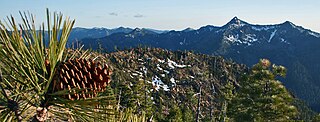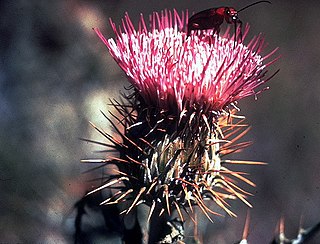| Cirsium andrewsii | |
|---|---|
 | |
| Scientific classification | |
| Kingdom: | Plantae |
| Clade: | Angiosperms |
| Clade: | Eudicots |
| Clade: | Asterids |
| Order: | Asterales |
| Family: | Asteraceae |
| Genus: | Cirsium |
| Species: | C. andrewsii |
| Binomial name | |
| Cirsium andrewsii (A.Gray) Petr. | |
| Synonyms [1] | |
| |
Cirsium andrewsii is an uncommon species of thistle known by the common name Franciscan thistle. It is endemic to California, where it is known from the coastline of the San Francisco Bay Area from Marin to San Mateo Counties. [2] There are also reports of isolated populations in the Klamath Mountains and in the Sierra Nevada. [3]

Cirsium is a genus of perennial and biennial flowering plants in the Asteraceae, one of several genera known commonly as thistles. They are more precisely known as plume thistles. These differ from other thistle genera in having feathered hairs to their achenes. The other genera have a pappus of simple unbranched hairs.

Endemism is the ecological state of a species being unique to a defined geographic location, such as an island, nation, country or other defined zone, or habitat type; organisms that are indigenous to a place are not endemic to it if they are also found elsewhere. The extreme opposite of endemism is cosmopolitan distribution. An alternative term for a species that is endemic is precinctive, which applies to species that are restricted to a defined geographical area.

California is a state in the Pacific Region of the United States. With 39.6 million residents, California is the most populous U.S. state and the third-largest by area. The state capital is Sacramento. The Greater Los Angeles Area and the San Francisco Bay Area are the nation's second and fifth most populous urban regions, with 18.7 million and 9.7 million residents respectively. Los Angeles is California's most populous city, and the country's second most populous, after New York City. California also has the nation's most populous county, Los Angeles County, and its largest county by area, San Bernardino County. The City and County of San Francisco is both the country's second-most densely populated major city after New York City and the fifth-most densely populated county, behind only four of the five New York City boroughs.
Cirsium andrewsii grows in coastal habitats such as sea bluffs and canyons, and is sometimes found on serpentine soils. The species is biennial to perennial, producing an erect, leafy stem which can reach two meters in height. It is highly branched, dense to clumpy, fleshy, and cobwebby with fibers, especially when new. The leaves are woolly or cobwebby, spiny along the edges, and sometimes lack lobes or deep cuts. They are borne on petioles with winged, spiny margins, some spines exceeding a centimeter in length. The inflorescence produces one or more flower heads, each up to 3 centimeters long by 5 wide, wispy with cobwebby fibers, and lined with very spiny phyllaries. The flower head is packed with dark purplish-pink flowers up to about 2.5 centimeters in length. The fruit is an achene with a dark brown body about half a centimeter long and a pappus about 1.5 centimeters long. [2]

Serpentine soil is mostly derived from ultramafic rocks; In particular, serpentinite, a rock formed by the hydration and metamorphic transformation of peridotite. Peridotite is an ultramafic rock from the Earth's upper mantle. Serpentinite is composed of the mineral serpentine; the two terms are often used to mean the rock and soil.

A biennial plant is a flowering plant that takes two years to complete its biological lifecycle. In the first year, the plant grows leaves, stems, and roots, then it enters a period of dormancy over the colder months. Usually the stem remains very short and the leaves are low to the ground, forming a rosette. Many biennials require a cold treatment, or vernalization, before they will flower. During the next spring or summer, the stem of the biennial plant elongates greatly, or "bolts". The plant then flowers, producing fruits and seeds before it finally dies. There are far fewer biennials than either perennial plants or annual plants.

A perennial plant or simply perennial is a plant that lives more than two years. Some sources cite perennial plants being plants that live more than three years. The term is often used to differentiate a plant from shorter-lived annuals and biennials. The term is also widely used to distinguish plants with little or no woody growth from trees and shrubs, which are also technically perennials.

















